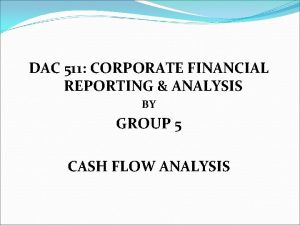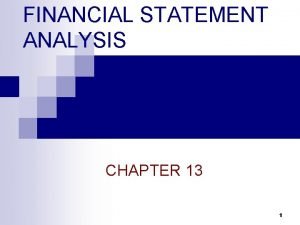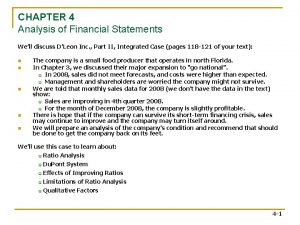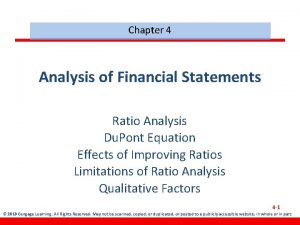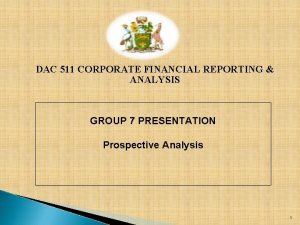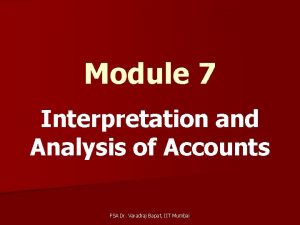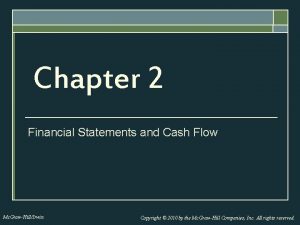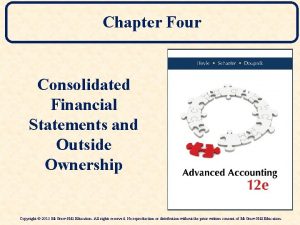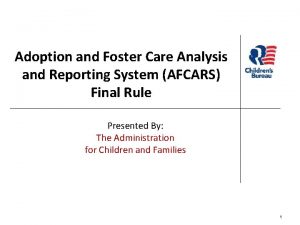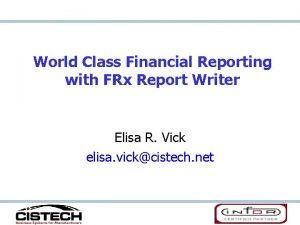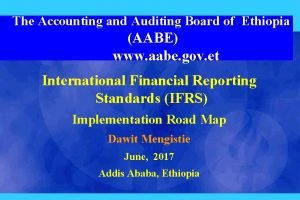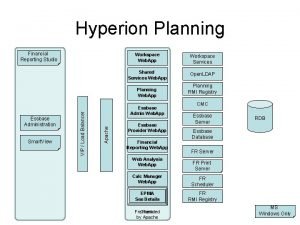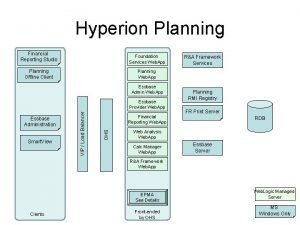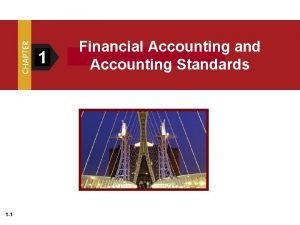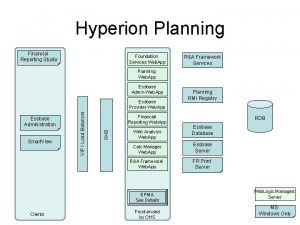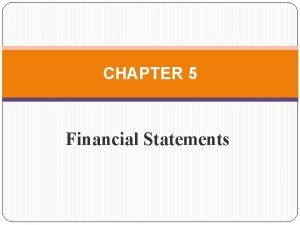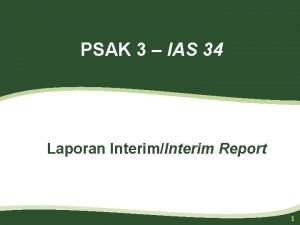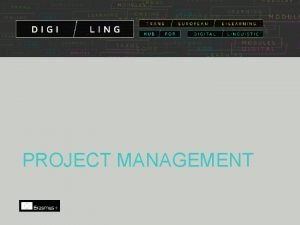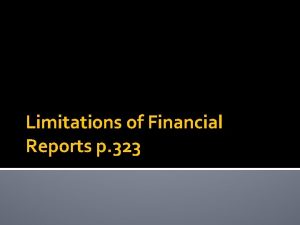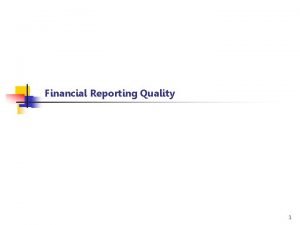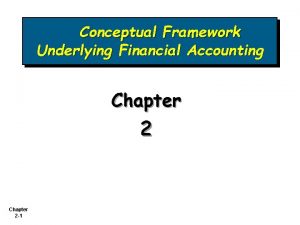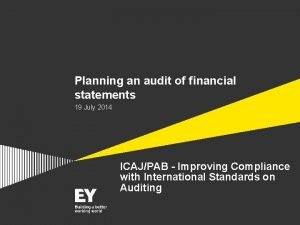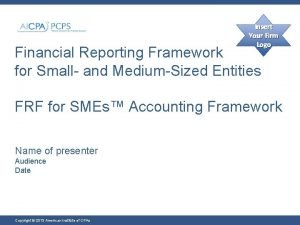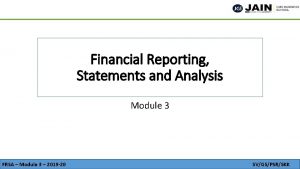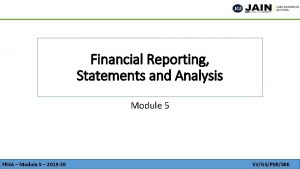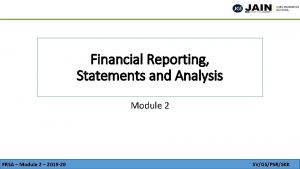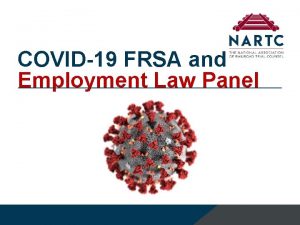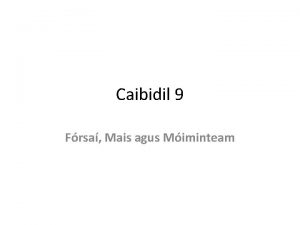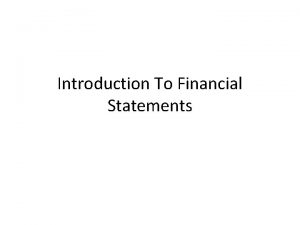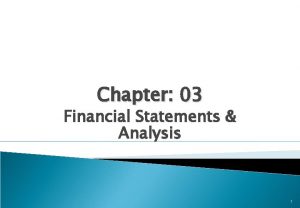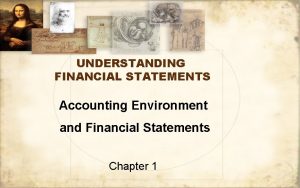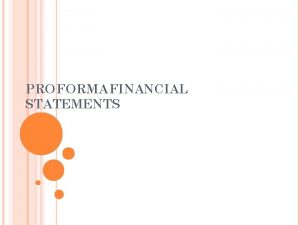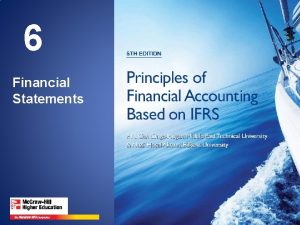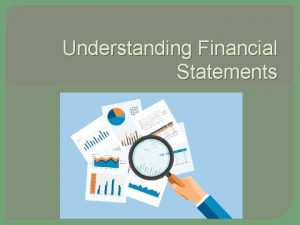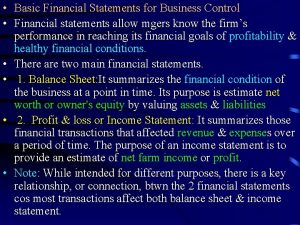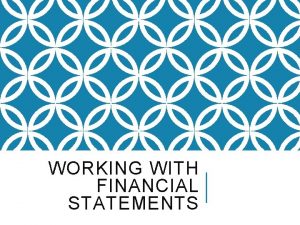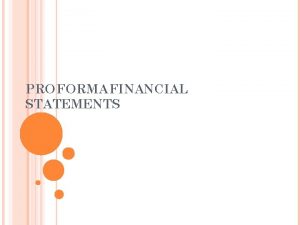Financial Reporting Statements and Analysis Module 4 FRSA


































- Slides: 34

Financial Reporting, Statements and Analysis Module 4 FRSA – Module 4 – 2019 -20 SV/GS/PSR/SKK

• Module 4 – Ratio Analysis • Learning Outcome • Able to analyse financial health through ratios • Content • Introduction to Ratios • Types of Ratios • • • Liquidity Ratios Solvency Ratios Activity Ratios Profitability Ratios and, Market Test Ratios FRSA – Module 4 – 2019 -20 SV/GS/PSR/SKK

• Introduction to Ratio • A ratio is a mathematical number calculated as a reference to relationship of two or more numbers and can be expressed as a fraction, proportion, percentage and a number of times. • Definition of Ratio • A ratio is defined as “the indicated quotient of two mathematical expressions and as the relationship between two or more things. ” Here ratio means financial ratio or accounting ratio which is a mathematical expression of the relationship between accounting figures. FRSA – Module 4 – 2019 -20 SV/GS/PSR/SKK

• Introduction to Ratio • Objectives of Ratio Analysis 1. To know the areas of the business which need more attention; 2. To know about the potential areas which can be improved with the effort in the desired direction; 3. To provide a deeper analysis of the profitability, liquidity, solvency and efficiency levels in the business; 4. To provide information for making cross-sectional analysis by comparing the performance with the best industry standards; and 5. To provide information derived from financial statements useful for making projections and future estimations. FRSA – Module 4 – 2019 -20 SV/GS/PSR/SKK

• Introduction to Ratio • Advantages of Ratio Analysis 1. Helps to understand efficiency of decisions 2. Simplify complex figures and establish relationships 3. Helpful in comparative analysis 4. Identification of problem areas 5. Enables SWOT analysis 6. Various comparisons FRSA – Module 4 – 2019 -20 SV/GS/PSR/SKK

• Introduction to Ratio • Limitations of Ratio Analysis 1. Limitations of Accounting Data 2. Ignores Price-level Changes 3. Ignore Qualitative or Non-Monetary Aspects 4. Variations in Accounting Practices 5. Forecasting FRSA – Module 4 – 2019 -20 SV/GS/PSR/SKK

• Types of Ratios • Liquidity Ratios - Liquidity or short-term solvency means ability of the business to pay its short-term liabilities. • Activity Ratios - These ratios indicate the speed at which, activities of the business are being performed. • Profitability Ratios - Profitability ratios are calculated to analyze the earning capacity of the business which is the outcome of utilization of resources employed in the business. • Solvency Ratios - Solvency ratios are calculated to determine the ability of the business to service its debt in the long run • Market Test Ratios – Theses ratios indicate the firms performance level to the investors of the stock market. FRSA – Module 4 – 2019 -20 SV/GS/PSR/SKK

• Liquidity Ratios • Liquidity ratios are calculated to measure the short-term solvency of the business, i. e. the firm’s ability to meet its current obligations. • Various Liquidity Ratios are: • Current Ratio • Quick Ratio or Acid Test Ratio • Cash Ratio or Absolute Liquidity Ratio • Basic Defense Interval or Interval Measure Ratios • Net Working Capital Ratio FRSA – Module 4 – 2019 -20 SV/GS/PSR/SKK

• Liquidity Ratios • Current Ratio = Current Assets / Current Liabilities • Quick Ratio or Acid Test Ratio = (Current Assets – Inventories-Prepaid Exp. ) Current Liabilities • Cash Ratio or Absolute Liquidity Ratio = Cash + Bank + Short Term Marketable Securities Current Liabilities • Net Working Capital Ratio = Current Assets - Current Liabilities (Excluding Short term bank borrowing) FRSA – Module 4 – 2019 -20 SV/GS/PSR/SKK

• Liquidity Ratios FRSA – Module 4 – 2019 -20 SV/GS/PSR/SKK

• Liquidity Ratios 3 FRSA – Module 4 – 2019 -20 SV/GS/PSR/SKK

• Liquidity Ratios FRSA – Module 4 – 2019 -20 SV/GS/PSR/SKK

• Q 5: Current ratio 2. 5. Working capital Rs. 60, 000. Calculate the amount of Current Assets and Current Liabilities. Q 6: Current ratio = 4. 5 Quick ratio = 3 Working Capital = Rs. 90, 000. Calculate the Current Assets, Current Liabilities and Stock. FRSA – Module 4 – 2019 -20 SV/GS/PSR/SKK

• Liquidity Ratios - Practice FRSA – Module 4 – 2019 -20 SV/GS/PSR/SKK

• Liquidity Ratios • Basic Defense Interval or Interval Measure Ratios • BDI is a financial metric that indicates the number of days that a company can operate without needing to access noncurrent assets, long-term assets whose full value cannot be obtained within the current accounting year, or additional outside financial resources. • BDI or IMR (expressed as number of days) = current assets / daily operational expenses • Current assets = cash + marketable securities + net receivables • Daily operational expenses = (annual operating expenses – non cash charges) / 365 FRSA – Module 4 – 2019 -20 SV/GS/PSR/SKK

• DIR • For example, • A company has Rs. 100, 000 cash on hand, Rs. 50, 000 worth of marketable securities, and Rs. 50, 000 in accounts receivables, it has a total of Rs. 200, 000 in defensive assets. • If the company's daily operational expenses equal Rs. 5, 000. • The DIR value is = current assets / daily operational expenses • = Rs. 200, 000 / Rs. 5, 000. • = 40 Days FRSA – Module 4 – 2019 -20 SV/GS/PSR/SKK

• DIR • Hammer Industries is suffering through a cyclical decline in the heavy equipment industry, but the cycle appears to be turning up. The company expects a cash-in-advance payment from a major customer in 60 days. In the meantime, the CEO wants to understand the ability of the company to stay in business at its current rate of expenditure. The following information applies to the analysis: • Cash = Rs. 1, 200, 000; Marketable securities = Rs. 3, 700, 000; Trade receivables = Rs. 4, 100, 000 • Average daily expenditures = Rs. 138, 500 • The calculation of the defensive interval ratio is: • ($1, 200, 000 Cash + $3, 700, 000 Marketable securities + $4, 100, 000 Receivables) ÷ $138, 500 Average daily expenditures • = 65 days FRSA – Module 4 – 2019 -20 SV/GS/PSR/SKK

• Activity Ratios - These ratios indicate the speed at which, activities of the business are being performed. • Various Types: • Debtors Turnover Ratio • Average Collection Period • Creditors Turnover Ratio • Average Payment Period • Total Assets Turnover Ratio • Inventory Turnover Ratio FRSA – Module 4 – 2019 -20 SV/GS/PSR/SKK

• Activity Ratios • Debtors Turnover Ratio = Credit Sales / Average Debtors • Average Collection Period = No. of days in a year or months / DTR • Creditors Turnover Ratio = Credit Purchases / Average Creditors • Average Payment Period = No. of days in a year or months/ CTR • Inventory Turnover Ratio = Net Sales or Cost of Goods Sold / Average Inventory • Total Assets Ratio = Net Sales / Total Assets FRSA – Module 4 – 2019 -20 SV/GS/PSR/SKK

• Activity Ratios 1. Calculate the Debtors Turnover Ratio and Average Collection Period from the following information: • Total sales = Rs. 4, 000 • Cash sales = 20% of total sales • Debtors on 1. 1. 2004 = Rs. 40, 000 • Debtors on 31. 12. 2004 = Rs. 1, 20, 000 2. From the following details, Calculate (a) Debtors Turnover Ratio and (b) Debtors Average Collection Period: • Total Sales - Rs. 4, 000 Sales Returns - Rs. 25, 000 • Cash Sales - Rs. 30, 000 Debtors – Rs. 10, 000 • Bills Receivables - Rs. 25, 000 FRSA – Module 4 – 2019 -20 SV/GS/PSR/SKK

• Activity Ratios 3. Calculate the Creditor’s Turnover Ratio from the following figures. • Credit purchases during 2005 = Rs. 12, 000 • Creditors + Bills Payables on 1. 1. 2005 = Rs. 4, 000 • Creditors + Bills Payables on 31. 12. 2005 = Rs. 2, 000 4. From the following information, calculate – • (i) Payable Turnover Ratio • (ii) Average Payment Period • Total Purchases - Rs. 80, 000; Cash Purchases – Rs. 20, 000 • Purchase returns - Rs. 5, 000; Sales returns – Rs. 10, 000 • Bills Receivables - Rs. 12, 000; Creditors – Rs. 20, 000 • Bills Payables - Rs. 15, 000; Debtors – Rs. 40, 000 FRSA – Module 4 – 2019 -20 SV/GS/PSR/SKK

• Activity Ratios 5. From the following information, calculate stock turnover ratio : • Opening Stock Rs. 18, 000 Wages Rs. 14, 000 • Closing Stock Rs. 22, 000 Sales Rs. 80, 000 • Purchases Rs. 46, 000 Carriage Inwards Rs. 4, 000 6. From the following information, calculate stock turnover ratio. • Sales: Rs. 4, 000, Gross Profit Ratio : 10% on Sales • Opening stock = Rs. 38, 500 Closing stock = Rs. 41, 500 • Note: Cost of Goods Sold = Sales – Gross Profit FRSA – Module 4 – 2019 -20 SV/GS/PSR/SKK

• Activity Ratios • The data extracted from the books of the two cement companies are provided below: Particulars Ambuja Cements (Rs. ) Acc Limited (Rs. )Rs. In Crore Sales 2500 2250 Purchases 1450 1125 Opening Stock 450 225 Closing Stock 275 145 Creditors 120 130 Debtors 240 220 Bills Payable 85 115 Bills Receivable 115 135 • Required: Compute the Following Ratios: (i) Debtors Turnover Ratio (ii) Creditors Turnover Ratio and (iii) Stock Turnover Ratio FRSA – Module 4 – 2019 -20 SV/GS/PSR/SKK

• Activity Ratios 7. From the following information, calculate (i) Total Assets Turnover (ii) Fixed Assets Turnover and (iii) Working Capital Turnover Ratios: (Rs. ) • Preference Shares Capital 4, 000 Plant and Machinery 8, 000 • Equity Share Capital 6, 000 Land Building 5, 000 • General Reserve 1, 000 Motor Car 2, 000 • Profit and Loss Account 3, 000 Furniture 1, 000 • 15% Debentures 2, 000 Stock 1, 80, 000 • 14% Loan 2, 000 Debtors 1, 10, 000 • Creditors 1, 40, 000 Bank 80, 000 • Bills Payable 50, 000 Cash 30, 000 • Outstanding Expenses 10, 000 Sales for the year 2018 were Rs. 30, 000. FRSA – Module 4 – 2019 -20 SV/GS/PSR/SKK

• Profitability Ratios • Gross Profit Ratio = Gross Profit / Net Sales x 100 • Net Profit Ratio = Net Profit / Net Sales x 100 • Operating Ratio = Cost of Goods Sold + Operating Expenses/ Net Sales x 100 • Operating Profit Ratio = Operating Profit / Net Sales x 100 • Operating Profit = Earnings before Interest and Taxes • Operating Profit = Operating Revenue - COGS - Operating Expenses Depreciation and Amortization FRSA – Module 4 – 2019 -20 SV/GS/PSR/SKK

• Profitability Ratios The data extracted from the books of the two FMCG companies are provided below: Particulars Sales Other Income Cost of Goods Sold Employee Benefit Cost Finance Cost Other Expenses Nestle (Rs. ) HUL (Rs. ) 800000 650000 25000 350000 300000 120000 85000 30000 150000 15000 Required: Compute the Following Ratios: (i) Gross Profit Ratio (ii) Net Profit Ratio (iii) Operating Ratio and (iv) Operating Profit Ratio FRSA – Module 4 – 2019 -20 SV/GS/PSR/SKK

• Profitability Ratios The data extracted from the books of the two FMCG companies are provided below: Particulars Sales Other Income Cost of Goods Sold Employee Benefit Cost Finance Cost Other Expenses Nestle (Rs. ) HUL (Rs. ) 800000 650000 25000 350000 300000 120000 85000 30000 150000 15000 Required: Compute the Following Ratios: (i) Gross Profit Ratio (ii) Net Profit Ratio (iii) Operating Ratio and (iv) Operating Profit Ratio FRSA – Module 4 – 2019 -20 SV/GS/PSR/SKK

• Profitability Ratios • ROI ( Return on Investment)/ROCE = Profit before Interest and Tax Capital Employed x 100 • Capital Employed = FA + CA - CL • ROE (Return on Equity) = PAT / Net worth X 100 • Net worth = Share Capital + Reserves and Surplus • ROTA (Return on Total Assets) = PAT / Total Assets FRSA – Module 4 – 2019 -20 SV/GS/PSR/SKK

• Profitability Ratios FRSA – Module 4 – 2019 -20 SV/GS/PSR/SKK

• Market Ratios • EPS = PAT – Preference Dividend / Number of Equity Shares • Price to Earnings Ratio = Market Price of the share/ EPS • Dividend Yield Ratio = Dividend per share / Market price of the Share x 100 • Book Value per share = Net Assets / Number of shares • Price to Book Value = Market price of the share/ Book Value per share FRSA – Module 4 – 2019 -20 SV/GS/PSR/SKK

• Market Ratios

• Solvency Ratios • Debt to Equity Ratio = Total Debt (Long Term Debt) / Equity • Capital Gearing Ratio = Total Debt / Total Capital Employed or Total Assets • Solvency Ratio = PAT + Depreciation / Total Liabilities • Equity or Proprietary Ratio = Shareholders Funds (or) Net worth Total Capital Employed or Total Assets • Interest Coverage Ratio = Net Profit before Interest and Taxes / Total Interest FRSA – Module 4 – 2019 -20 SV/GS/PSR/SKK

• Solvency Ratios

• Balance Sheet Construction Future Retail Limited provides the following information as on 31. 3. 2018 Particulars Rs. Working Capital Bank Overdraft Fixed Assets to Proprietary Funds ratio Reserves and Surplus Current ratio Liquid ratio 2, 40, 000 0. 75 1, 60, 000 2. 5 1. 5 Required: Prepare a summarized Balance Sheet as at 31. 03. 2018 FRSA – Module 4 – 2019 -20 SV/GS/PSR/SKK
 Corporate financial reporting and analysis
Corporate financial reporting and analysis Financial statements and ratio analysis chapter 3
Financial statements and ratio analysis chapter 3 Financial statements and ratio analysis chapter 3
Financial statements and ratio analysis chapter 3 Banking financial statement analysis
Banking financial statement analysis Chapter 13 financial statement analysis
Chapter 13 financial statement analysis Chapter 4 analysis of financial statements
Chapter 4 analysis of financial statements Chapter 4 analysis of financial statements
Chapter 4 analysis of financial statements Prospective analysis financial statements
Prospective analysis financial statements Horizontal analysis interpretation
Horizontal analysis interpretation Statement
Statement 2-2 journal: financial statements and cash flow management
2-2 journal: financial statements and cash flow management Unit 13 accounting and financial statements
Unit 13 accounting and financial statements Cffa finance formula
Cffa finance formula Partial equity method consolidation worksheet
Partial equity method consolidation worksheet Adoption and foster care analysis and reporting system
Adoption and foster care analysis and reporting system C device module module 1
C device module module 1 Frx report designer
Frx report designer Aabe ethiopia website
Aabe ethiopia website Purposes of financial statements
Purposes of financial statements What is financial reporting studio?
What is financial reporting studio? What is oracle financial reporting studio?
What is oracle financial reporting studio? Us gaap conceptual framework
Us gaap conceptual framework The major key players on the international side are the:
The major key players on the international side are the: What is financial reporting studio?
What is financial reporting studio? Ethiopian government accounting
Ethiopian government accounting Cbd financial reporting framework
Cbd financial reporting framework Ias 34 interim financial reporting
Ias 34 interim financial reporting Project management financial reporting
Project management financial reporting Normalised earnings limitations
Normalised earnings limitations Intermediate accounting chapter 2
Intermediate accounting chapter 2 International financial reporting standards 9
International financial reporting standards 9 Limitations of financial reporting
Limitations of financial reporting Conceptual framework underlying financial accounting
Conceptual framework underlying financial accounting Planning an audit of financial statements
Planning an audit of financial statements Sample notes to financial statements for small entities
Sample notes to financial statements for small entities
